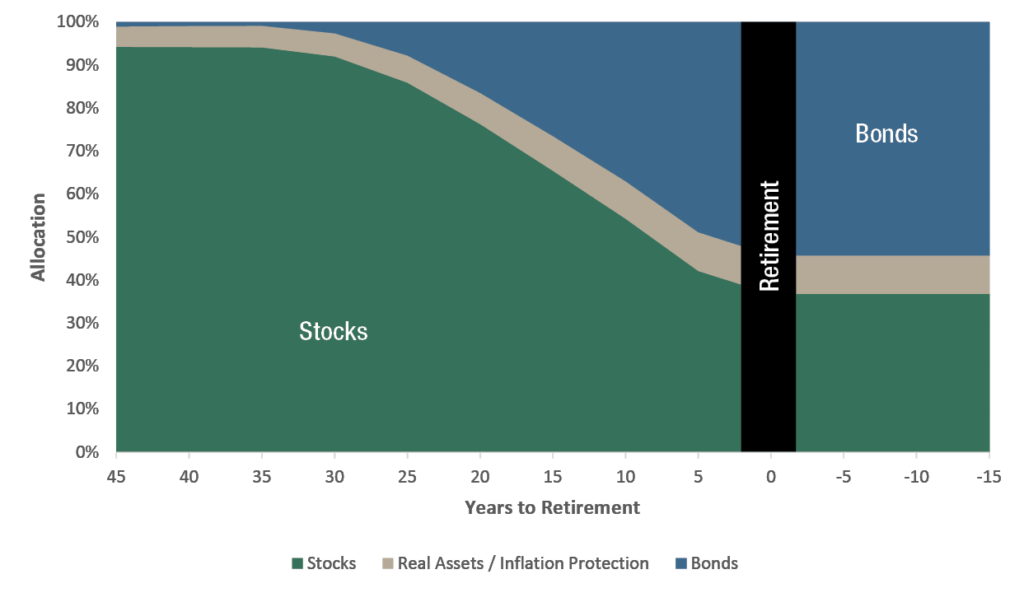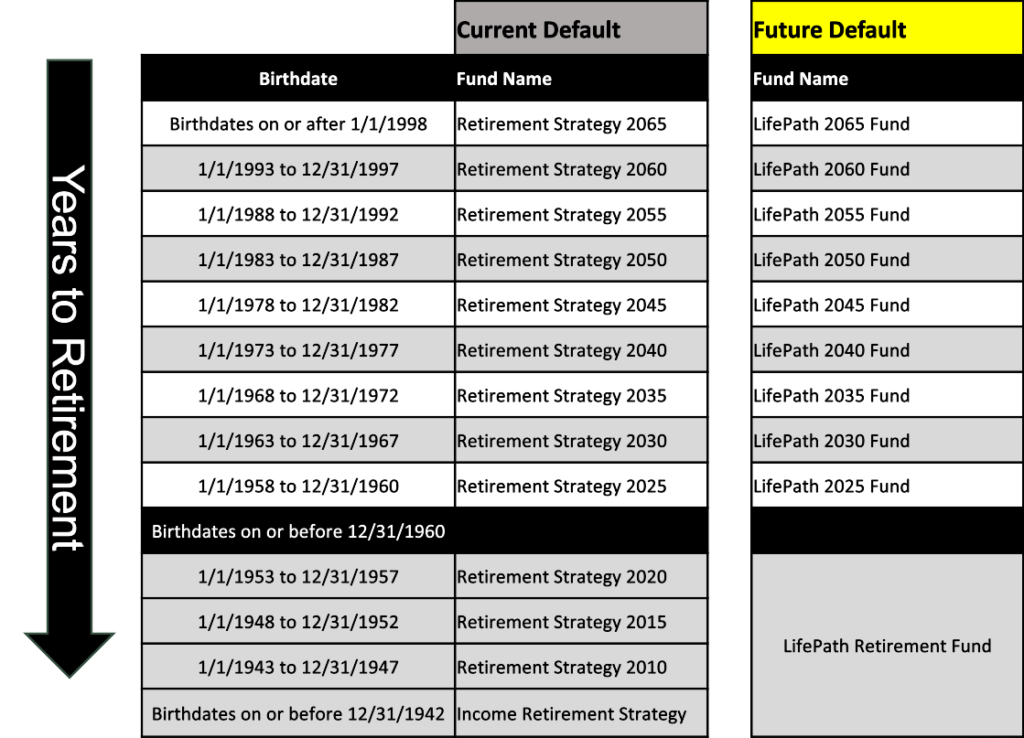Funds Transition
At MERS, our mission is to partner with those who serve Michigan communities to provide retirement benefits and related services to support a secure retirement. As part of our fiduciary responsibility, we actively select and monitor the investment choices that are available to you. As part of this ongoing evaluation, we are making a change to the target date funds that are offered to our participants.
As of, April 27, 2023, MERS moved the Retirement Strategy target date funds to the LifePath target date funds.
We’ve chosen the LifePath target date funds because they are designed for people who want:
- Comfort knowing they’re on a path to secure retirement
- Opportunity to grow savings
- Freedom to focus on what’s important
There is no action needed from participants currently investing in a Retirement Strategies fund. Invested assets automatically transitioned to the appropriate LifePath fund.
When we’re young, we have years ahead of us, so we may be willing to take more risk as we endure the typical ups and downs of the market. But, as we get older, we may need to start reining in the risk to help protect our savings. LifePath helps you do just that – through target date funds.
Target date funds are professionally managed, diversified investments, meaning investing in only one LifePath fund can provide a robust investment solution.
Based on your birth date, you will be placed in the fund closest to your ‘target date’ – the year you turn age 65. BlackRock’s investment professionals will carefully adjust the fund as the target date approaches. The fund will include a mix of investments, including global and U.S.-based stocks and bonds, which BlackRock’s investment managers will slowly change to reduce risk exposure over time.

When planning for your future, you may wish to discuss your investment options with a trusted financial advisor.
Fund Mapping
Invested assets in the Retirement Strategies automatically transitioned to the appropriate LifePath fund.
LifePath fund sheets can be found below this chart.

Fund Sheets
![]() 2025 LifePath
2025 LifePath
![]() 2030 LifePath
2030 LifePath
![]() 2035 LifePath
2035 LifePath
![]() 2040 LifePath
2040 LifePath
![]() 2045 LifePath
2045 LifePath
![]() 2050 LifePath
2050 LifePath
![]() 2055 LifePath
2055 LifePath
![]() 2060 LifePath
2060 LifePath
![]() 2065 LifePath
2065 LifePath
Returns for LifePath Target Date Funds: Historical returns prior to MERS including the funds on its investment menu (before May 1, 2023), provided by BlackRock, are provided for informational purposes only and do not include MERS Total Annual Operating Expenses. Returns for periods greater than one year are annualized. Past investment performance is no guarantee of future investment results. Current investment performance may be higher or lower. Funds are subject to investment risk (the chance that returns from companies in which the fund is invested will trail returns from other asset classes or the overall market) from a number of sources, including the management style of the fund and market volatility; markets can rise or decline significantly in response to company, political, regulatory, market, or economic developments. A fund’s total return, like securities prices generally, may fluctuate within a wide range. As a result, investors may lose money over short or long periods.
>> View FAQs
FAQs
About LifePath Target Date Funds
What are LifePath Target Date Funds?
LifePath is a suite of target date funds. A target date fund is a professionally managed, diversified investment portfolio packaged into a single investment. LifePath is designed so that investing in only one LifePath fund can provide a robust investment solution.
Who should consider investing in LifePath?
LifePath is designed for investors who would prefer not to manage their own retirement plan investment portfolio. Investment professionals focus on managing the risk in the LifePath target date funds, helping to free up your time to focus on the other important things in life.
How do participants choose a LifePath Target Date Fund?
When considering a LifePath fund, participants can identify an approximate target date for when they may want to retire. Let’s say a participant wants to retire when he/she is 65, and the participant turns 65 in 2039. That means the participant could pick the LifePath 2040 fund—the portfolio closest to the ‘target year.’
To help participants find the right fund for them, the LifePath Selector Tool may be helpful.
What if a participant expects to retire during a year not targeted by one of the LifePath funds?
A participant can choose the LifePath fund that is closest to his/her target year, such as LifePath 2025 if the participant is looking to retire in 2023. To help you select the fund that most closely aligns with your goals, check out the LifePath Selector Tool.
Can participants also invest in other investment options?
LifePath is designed and constructed to manage all the money in a participant’s retirement savings plan. However, participants can choose to invest all or a portion of their funds in other MERS investment options if they wish.
It’s been said that diversification means not putting all your eggs in one basket. How is it that LifePath can be diversified if all the plan assets are invested in one fund?
LifePath invests in several different asset classes, so participants don’t have to mix and match them on their own. LifePath funds are invested mainly in global and U.S.-based stocks early on, shifting to more conservative investments, such as bonds, as retirement approaches—keeping the fund diversified the entire time.
What happens at the target year?
When a LifePath fund reaches its target year, the assets in the funds will automatically move into LifePath Retirement Fund, which is designed to provide the potential for income and moderate long-term growth for investors during their retirement years.
What are some types of investments that LifePath may hold?
As of June 30, 2022, LifePath may include the following asset classes:
- U.S. Mid/Large-cap Stocks
- U.S. Small-cap Stocks
- International Stocks
- Global Real Estate
- U.S. Inflation-linked Bonds
- Commodities
- Intermediate Government Bond
- Long Government Bond
- Intermediate Credit
- Long Credit
- Securitized
These holdings may change over time.
Who manages LifePath?
BlackRock is the investment firm offering LifePath and BlackRock portfolio managers manage the funds. BlackRock pioneered target date funds in 1993 with the launch of LifePath Funds. BlackRock is dedicated to offering quality investment solutions to help investors achieve their retirement goals. As of June 30, 2022, the firm manages U.S. $8.48 trillion in assets.
What is “rebalancing”?
Rebalancing is the process of realigning the percentage of assets invested in each investment of a fund. As each investment within a fund can grow at different rates, at certain points in time, investments are “reset” to their original allocation.
How often does LifePath rebalance?
The LifePath funds’ asset and risk allocation is monitored on a daily basis and the funds are typically rebalanced at the end of the month.
Where do I see historical performance for the LifePath funds?
After May 1, 2023, the LifePath fund sheets by year will be available for participants to view from the “Fund” tab button at the top of this page, or after logging into myMERS, selecting your plan, View Plan Summary, then to the Investment Performance Tab. Note that any historical returns are prior to MERS including these funds on its investment menu (before May 1, 2023), provided by BlackRock and are for informational purposes only and do not include MERS Total Annual Operating Expenses.
Transition Questions
What is the transition timeline?
| Date | Activity |
|---|---|
Thursday, April 27 4:00 p.m. |
Quiet Period Begins
|
Tuesday, May 2 |
Quiet Period Ends
|
Will assets be out of the market during this transition?
No, assets are not expected to be out of the market at any time.
Are investment changes allowed during the transition?
During the quiet period, no investment allocation changes are allowed.
Is there any expected impact on distributions or rollovers?
Participants who submit requests for distributions or rollovers during the quiet period (April 28th, 29th, 30th or May 1st) may experience a slight delay in normal processing. This also includes anyone with a regularly scheduled installment payment during the quiet period; your payment may be delayed by one day after the quiet period ends.
Resources
Fund Sheets
![]() 2025 LifePath
2025 LifePath
![]() 2030 LifePath
2030 LifePath
![]() 2035 LifePath
2035 LifePath
![]() 2040 LifePath
2040 LifePath
![]() 2045 LifePath
2045 LifePath
![]() 2050 LifePath
2050 LifePath
![]() 2055 LifePath
2055 LifePath
![]() 2060 LifePath
2060 LifePath
![]() 2065 LifePath
2065 LifePath
Returns for LifePath Target Date Funds: Historical returns prior to MERS including the funds on its investment menu (before May 1, 2023), provided by BlackRock, are provided for informational purposes only and do not include MERS Total Annual Operating Expenses. Returns for periods greater than one year are annualized. Past investment performance is no guarantee of future investment results. Current investment performance may be higher or lower. Funds are subject to investment risk (the chance that returns from companies in which the fund is invested will trail returns from other asset classes or the overall market) from a number of sources, including the management style of the fund and market volatility; markets can rise or decline significantly in response to company, political, regulatory, market, or economic developments. A fund’s total return, like securities prices generally, may fluctuate within a wide range. As a result, investors may lose money over short or long periods.



